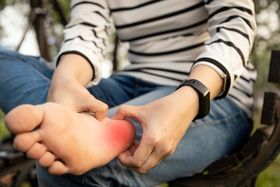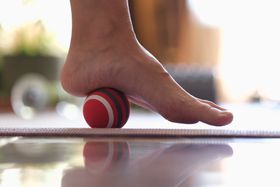Secondary Conditions Associated With Flat Feet
Updated January 30, 2024

Flat feet is a condition in which the foot arch flattens out completely, causing the whole sole of the foot to rest on the floor when standing. Flat feet can occur in childhood with the non-development of the foot arch and, in some cases, due to an injury to the foot arch or supporting tendon.
How Do Flat Feet Affect the Body?
Initially, flat feet are asymptomatic. The condition causes pronation and overpronation, with your foot and ankle rolling inwards when you walk so that you bear more weight on the inner border of your foot. This effectively pushes the foot out of alignment with the rest of the kinematic chain.
To maintain your posture and balance, the lower leg muscles have to compensate for the malalignment. Consequently, there is more tension in some areas than usual, and over time, this may have complications or worsen existing injuries.
» Take a look at the best insoles for flat feet
Which Secondary Conditions Are Associated With Flat Feet?
If this condition only affected the foot, it would not lead to as many problems—but unfortunately, it doesn't. The increased tension in the foot causes far-reaching complications that go beyond the foot, affecting the ankles, knees, hips, and even the spine.
Many of these complications are also musculoskeletal. Some of the secondary conditions associated with flat feet include:
- Degenerative disc disease Flat feet increase the strain on the back, as weight transfer through the spine to the feet is incorrect. As a result, there is a quicker degeneration of the spinal discs, leading to symptoms such as severe back pain from flat feet. You may also experience weakness and numbness as nerves become impinged.
- Corns and calluses Because the entire sole is in contact with the ground, weight transfer is not as efficient. As a result, some areas of the foot bear more weight than others, causing painful corns and calluses to form on the foot.
- Toe deformities Flat feet also place extra stress on the big toe and second toe, causing deformities like bunions to develop on the toe. This, in turn, worsens the foot condition and a vicious cycle of pain, and more pain results.
- Plantar fasciitis This refers to the inflammation of the plantar fascia—the long ligament located at the bottom of the foot, which supports the foot arch. Flat feet put extra strain on the plantar fascia, resulting in irritability and inflammation.
- Degenerative changes in the ankle and foot joints Evidence suggests that degeneration is faster in the ankle and foot joints of people with flat feet due to the inefficient transfer of energy through those joints. It can even cause the feet to feel too weak to support the body. The insides and bottom of the feet will also have an increased penchant for swelling after prolonged standing or walking.
- Knee pain Flat feet predispose the foot to excessive pronation, which in turn causes the knees to rotate internally into a "knock-kneed" position. This leads to patellofemoral pain syndrome and iliotibial band syndrome.
- Hip pain Flat feet affect the gait, and the body's attempt to compensate increases the tension on the joints, muscles, and ligaments of the hip, causing hip pain.
How to Prevent Flat Feet From Causing Further Problems
At first, flat feet are not at all symptomatic. It is best to keep it this way and prevent flat-foot complications from setting in. At this point, interventions aim to support the fallen arches, strengthen the feet and ankles, and relieve pain symptoms. There are both conservative and invasive treatments for flat feet.
The following treatments are commonly used to prevent flat feet from causing further issues:
- Use of orthotics Orthotics inserts can help relieve some of the load placed on the foot by its inward roll during overpronation. There are various types of custom orthotics, and you will need to determine whether rigid or soft orthotics are best for your needs. Orthotics reduce the chances of developing overuse or strain injuries during physical activity.
- Physical therapy A physiotherapist will prescribe the appropriate strengthening and stretching exercises for flat feet. These help strengthen the muscles of the lower leg and the arch and stretch any taut tendons and muscles to relieve the strain on them. Joint mobilization may also be incorporated to loosen up jarred joints.
- Proper footwear Supportive footwear with wide toe spaces will support the foot, elevate the foot arch, and give the toes wiggle room. Finding the best insoles for your flat feet is also highly recommended. If you're looking for further information, take a look at this article on the best footwear and insoles for flat feet from a physical therapist's perspective.
- Bracing or Taping Bracing or taping the feet in a certain way can help position the foot correctly and stabilize it. This treatment is often advised at the acute stage.
- Surgical intervention Where the above treatments are conservative, sometimes more invasive methods are required. If flat feet are due to structural problems, surgery may be necessary to restore the foot to its anatomical position.








